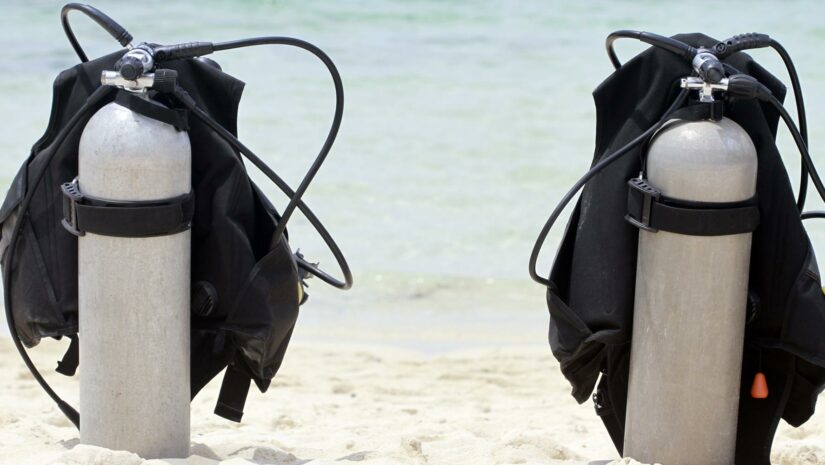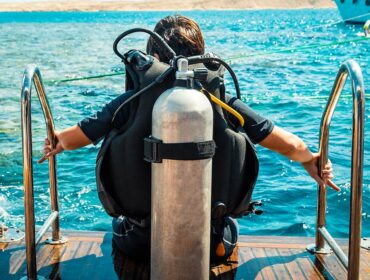If you’re looking to take that leap and purchase your first scuba tank or diving cylinder, there are a few things you will need to consider—the first of which is what type of material it should be made of based on your own specific diving needs. You’ve probably already heard that there are two types of metals commonly used for scuba tanks: steel vs aluminum. But what’s the difference between these two, and which one will best suit your style of diving? In this article, we discuss a few factors you need to consider when choosing between steel and aluminum tanks.
Steel vs Aluminum Scuba Tanks
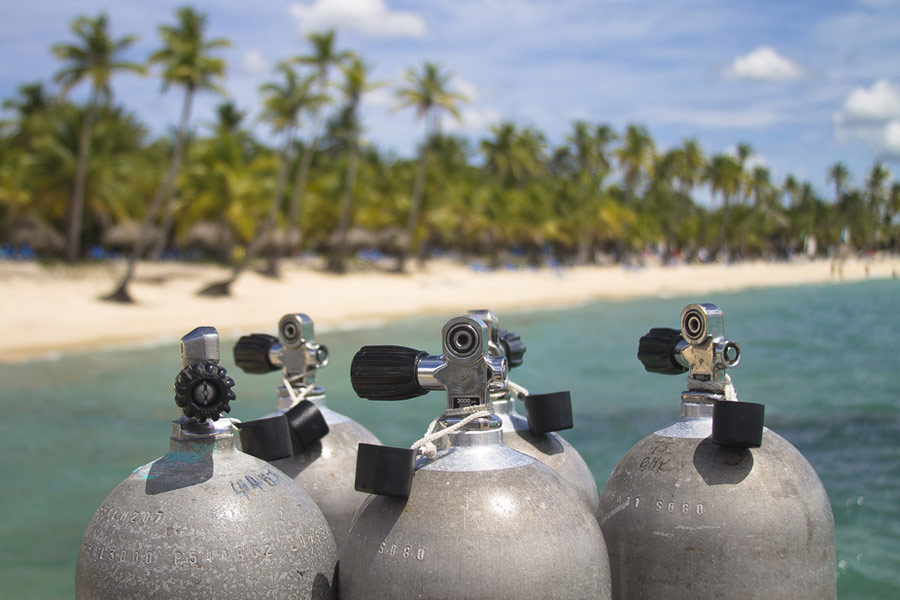
So what are the differences between a steel scuba tank and an aluminum scuba tank? Well firstly, steel is harder and more durable than aluminum, this makes it less likely to scratch or dent. Because it is softer, tanks that are made from aluminum are built with thicker walls to be able to hold the same air pressure as a steel scuba tank. So although steel is heavier than aluminum, a steel tank will feel lighter due to its thinner walls. However, steel tanks are more likely to rust from exposure to moisture, so may need to be periodically “tumbled,” which is a process that removes oxidation from inside the tank.
Here are some more major differences between steel vs aluminum scuba tanks:
Size & Weight
When choosing between steel and aluminum scuba tanks, it’s important to consider dry weight and size, as these can affect your buoyancy and overall comfort.
In scuba diving, dry weight refers to how much a tank weighs on land—and it’s something you’re going to want to consider if you plan on lugging your tank around when you’re not in water. Steel is stronger and more durable than aluminum, which is why tanks made with the latter usually have thicker walls to compensate for the reduced tensile strength. However, this does make them heavier than steel tanks. A standard steel cylinder with a capacity of 80 cubic feet (cf) will weigh around 28 to 30 pounds, while its aluminum counterpart will normally weigh somewhere between 31 to 35 pounds.
Size is also an important consideration when it comes to choosing a tank, especially if you’re on the smaller or shorter side. Large cylinders (and sometimes even the standard ones) can be too big for young divers or smaller female divers, which can result in them hitting their heads or legs on the tank while underwater.
Because less material is needed to make them, steel tanks are usually slightly smaller and lighter than aluminum. Most steel and aluminum tanks have a diameter of 7.25 inches, with a height of around 20 to 30 inches.
Capacity & Pressure
A scuba tank’s capacity is determined by its size and pressure rating. Most tanks have capacities ranging from 50 to 120 cf, with various compressed air pressures: low-pressure (LP) with 2400-2650 psi, standard pressure with 3000 psi, and high-pressure (HP) at 3300-3500 psi.
Standard aluminum tanks typically have a capacity of 80 cf, with a standard service pressure of 3000 psi—but usually not higher than 3300 psi. This is because the higher the pressure, the thicker the tank walls will have to be to contain the gas safely.
If you prefer a higher pressure tank, steel is usually the ideal choice. An HP steel tank can hold more air than its low-pressure counterpart, plus it’s lighter and more compact. However, keep in mind that while HP tanks may seem like the better option, LP tanks have a few advantages that may be important to some divers. First, there are plenty of tank fill stations that are not equipped to fill HP tanks properly. Second, higher pressures cause more stress on the regulator and valve components—although this is typically no longer a problem with today’s modern HP tanks.
A good, versatile option is to purchase a high-capacity HP steel tank and routinely underfilling it to a much lower psi than its maximum pressure rating. This gives you enough gas for your dive while reducing stress on your other equipment, and gives you the option of filling to a higher psi when your dive requires it.
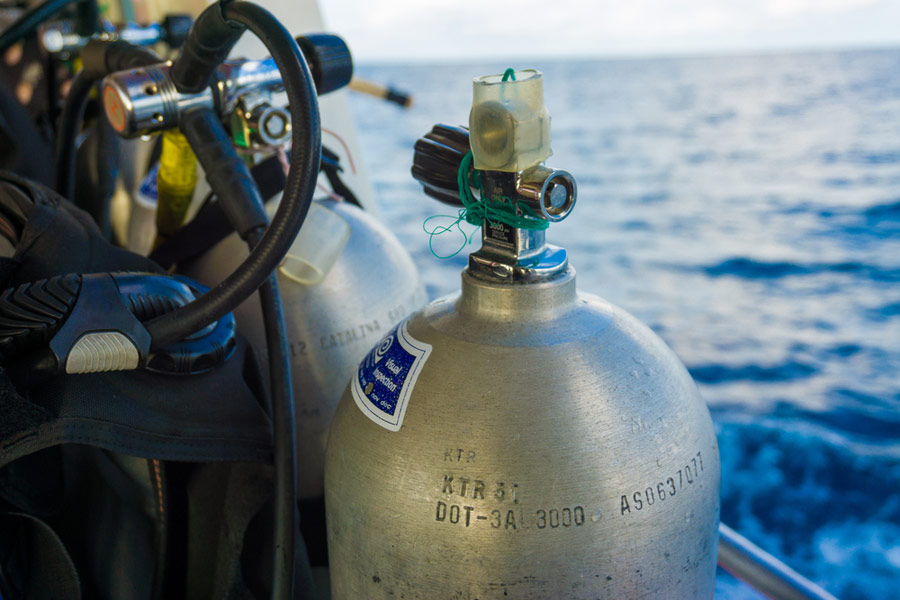
Durability & Longevity
As previously mentioned, aluminum is a softer metal than steel, which means it will dent, crack, or scratch more easily—usually in the tank neck. Nevertheless, aluminum is still widely preferred around the world for being more economical and easier to maintain.
With proper maintenance, steel tanks are more likely to last longer than aluminum ones. Thanks to the metal’s denser composition, steel is much tougher and more damage-resistant. However, compared to aluminum, it can be more prone to corrosion—particularly when exposed to saltwater. Steel tanks can also be damaged if moisture is introduced during the fill process, as this can cause oxidation later on. They require periodic tumbling to remove oxidation from the interior.
Either type will still require the same visual and hydro inspections. Check your local requirements to determine how frequently you should have your tank inspected. Regular inspections are essential as they will reveal any possible cracks or defects in the tank structure before they become dangerous.
Buoyancy
The type of tank you choose will also affect your buoyancy and weighting. Aluminum tanks are negatively buoyant when they are full, but become more positively buoyant as air is consumed. This means that by the time an aluminum tank is empty, it will float to the surface.
Steel tanks also start off negatively buoyant, but they typically remain so throughout most of the duration of the dive. They will eventually become more neutrally buoyant, but not by much. They also won’t float as aluminum tanks tend to do once emptied. However, keep in mind that this is somewhat dependent on the specific steel tank manufacturer. If you are fine-tuning your buoyancy to the point where you’re factoring changes in tank pressure, be sure to verify the buoyancy characteristics of a tank before purchasing.
Divers may need to add weight regardless of whether the tank is steel or aluminum, and the amount of additional weight will depend on the tank’s positive buoyancy upon completion of the dive. This is essential to achieve neutral buoyancy during the dive and to be able to safely complete decompression stops (if you need to perform any) during ascent.
One thing to keep in mind if you plan on diving in different bodies of water is that no matter what type of tank you have, whether steel or aluminum, any object is more naturally buoyant in saltwater since it is denser than freshwater.
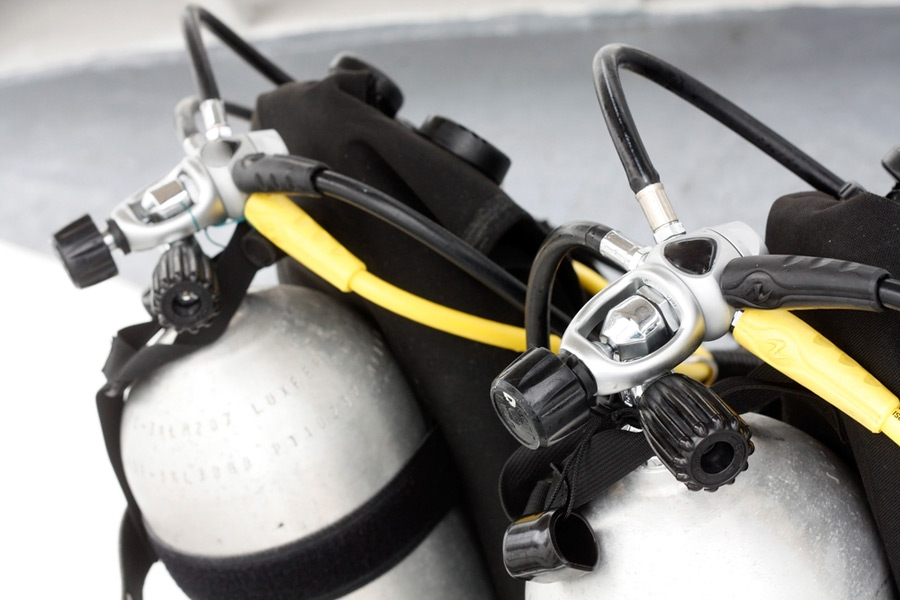
Price
One of the last determining factors when choosing a tank to dive with is the price of the tank. Aluminum tanks are normally less expensive than comparable steel tanks, making them an excellent choice for recreational diving and divers on a budget. But while steel tanks do cost more, they typically last longer and are more capable of supporting longer dives with increased air pressures.
Pros of a steel scuba tank
Why might you choose a steel scuba tank? Let’s look at the good qualities that a steel tank has.
The main pro of a steel tank is that it is likely to last longer than an aluminum scuba tank (with proper care and maintenance) because it is stronger and less likely to dent or scratch. Another pro to steel tanks is that they are more negatively buoyant than aluminum tanks. Even though they are lighter on the surface, they will be negatively buoyant underwater, even when you are breathing the air from it. This allows divers to wear less weight on their weight system.
Cons of a steel scuba tank
Steel tanks might be sounding pretty ideal, but there are a few negatives to consider.
As mentioned above, steel scuba tanks are more prone to rust from exposure to moisture. This can be fixed but it is something that you will have to think about more than with an aluminum scuba tank. Steel tanks are generally a lot more expensive to buy than aluminum tanks, so this is something you might want to consider if you are on a budget.
Pros of an aluminum scuba tank
Now we have looked at the pros and cons of a steel tank, let’s see why aluminum also has a lot to offer.
Firstly, aluminum scuba tanks are cheaper to buy than steel tanks. This could be an important factor when you start adding up all the costs of your dive gear. Secondly, as we know, aluminum is less prone to rust and corrosion from salt water, so that is a big pro if you don’t want to always be worrying about the health of your tank (however it will still need to undergo inspections from time to time).
Cons of an aluminum scuba tank
Aluminum scuba tanks may be cheaper, but you do have to be more careful with them as they are made from a softer material and are more likely to dent or scratch than a steel tank. You will also need to wear more weight on your weight belt when diving with an aluminum tank, because they become less negatively buoyant than a steel tank does when they become empty as you breathe the air.
Conclusion: Should You Pick Steel vs Aluminum Scuba Tanks?
After reading this comparison article, you’re probably thinking that steel is better than aluminum. However, this is not necessarily the case. Every diver has unique needs, so you need to consider your own before making the final decision. One way to figure it out is to rent both types of tanks on different occasions—see which one works best for you.
Also, if you’re buying a used tank, check it for current inspection stickers and markings. Weigh the pros and cons of purchasing a used tank that may not have been well cared for over buying a new one that would be expected to last through thousands of dives.
Now we have looked at the pros and cons of steel vs aluminum scuba tank, you can make an informed decision about which one to buy.

